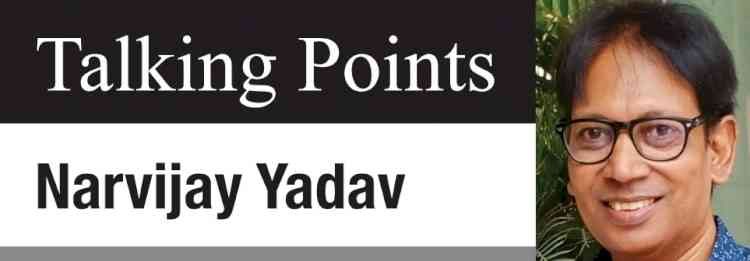The nation can’t afford damage to public property
As the ongoing protest of the youth against the Agnipath scheme for 4-years recruitment in the Indian armed forces has spread to 19 states, large-scale damage has been done to the national property including railway stations, trains, buses, and other government vehicles at different places in the country.

As the ongoing protest of the youth against the Agnipath scheme for 4-years recruitment in the Indian armed forces has spread to 19 states, large-scale damage has been done to the national property including railway stations, trains, buses, and other government vehicles at different places in the country. There are incidents of sabotage and arson. Railway tracks and roads are also being blocked due to which the general public is facing a lot of trouble. Violent agitations started after the Central Government announced the Agnipath scheme on June 14. The agitations began in Bihar and spread to Uttar Pradesh, Punjab, Haryana, and many other states. Surprisingly, news related to sabotage, violence and road blocking, and agitation is being given in detail in the newspapers, but nowhere in these reports is mentioned which organization or political party is spearheading or fuelling the movement. One thing is very clear unorganized youth cannot run such a large-scale movement on their own. Surely there will be such political parties behind this stir, who do not like peace and prosperity in India and who intend to run their shops by burning the country.
Such incidents have been happening again and again in the country for the last few years, when there is a large-scale ruckus and protest as soon as a new scheme of the central government is implemented. The surprising thing is that when big schemes are implemented, why are the schemes not publicized widely in advance? Why is public opinion not taken on schemes which have a large-scale impact? Why don’t the schemes properly explained to the stakeholders? What's the point of suddenly forcing a plan on the public? Due to the communication gap, the country has to suffer heavy losses time and again. The same shortcoming was noticed during the time of the controversial Farm Laws. In June 2020, the three agricultural laws were approved by the parliament in a hurry, when the country was under lockdown and the distribution of newspapers had come to a standstill. Now the Agnipath scheme has been announced in the same manner for the recruitment of short-service Agniveers in the armed forces.
The scale at which the Agnipath programme is being opposed, raises the question that why not those people are not informed in advance for whom the plans are made? Why their opinion is not taken into account at the beginning itself? Why not such plans are reconsidered even after their stiff opposition. So much sabotage, violence, loss, and trouble caused to the general public, and loss of government property can be avoided if the communication gap is not maintained. At the same time, youth are also expected to behave responsibly. On the one hand, they want to join the army, and on the other side, they are involved in the sabotage of public property. This is not done. Even peacefully you can register your protest. Why do you resort to violence? Why are you damaging government property, which is basically a public asset?
The youth involved in violent protests should understand one thing very well the records of agitators are kept with the police. Due to this reason, the youth involved in such criminal acts may face a lot of difficulty in getting government jobs in the future. Youth have the right to protest against the Agnipath scheme of the government, but they do not have the right to damage national property. It is also a crime to cause inconvenience to the citizens of the nation. Violence should never happen in the name of protest. Sabotage cannot be accepted under any circumstances.
People are also being harassed by the new-age digital loan providers. Many digital companies on social media give enticing advertisements for easy loan lending. The reactions of the borrowers show that they got the loan easily, but have been facing many problems later. These companies may charge interest arbitrarily and harass the borrowers in various ways if the money is not returned. Reserve Bank of India (RBI) Governor, Shakti Kant Das is worried about this pattern. He has said that the banking sector is passing through a major transformation and the Reserve Bank of India is looking to issue guidelines to strengthen the digital lending ecosystem soon. The rules will be tightened on the digital companies giving loans because it has become necessary to do so in the interest of the common people. With the entry of technology-based giants such as Google, Amazon, and Facebook (Meta) into the financial sector, the threat to ordinary consumers will increase further. The entry of such giant companies into the financial business will not only increase competition but will also raise questions about the privacy of data. It is necessary to assess such risks and put in place mechanisms to deal with them. Thanks to the RBI for smelling the trouble and taking measures.
In the front of the development, the construction work of the expressway between Delhi and Dehradun is going on in full swing. On completion, it will take only two and a half hours to reach Dehradun from Delhi, whereas it takes 6 to 7 hours currently. The target is to have the expressway ready by 2024. In its construction, an 18-km-long elevated road is being prepared through Rajaji National Park without disturbing water, forest, and mountain, for which the work of building pillars is going on. For the first time in the country, underpasses are being developed for the movement of wildlife. The speed limit of vehicles on this route will be 100 km per hour. The Delhi-Dehradun Expressway will pass through the Rajaji National Park which is home to several species of wildlife like Guldar, Barasingha, Deer, Elephant, Crocodile, and Nilgai. After the construction of the Delhi Dehradun Expressway, it will be easy to go from Punjab, Haryana, Himachal Pradesh, and Jammu and Kashmir to Delhi, Western Uttar Pradesh, and Uttarakhand.
(The writer is a senior journalist & columnist)


 Narvijay Yadav
Narvijay Yadav 








